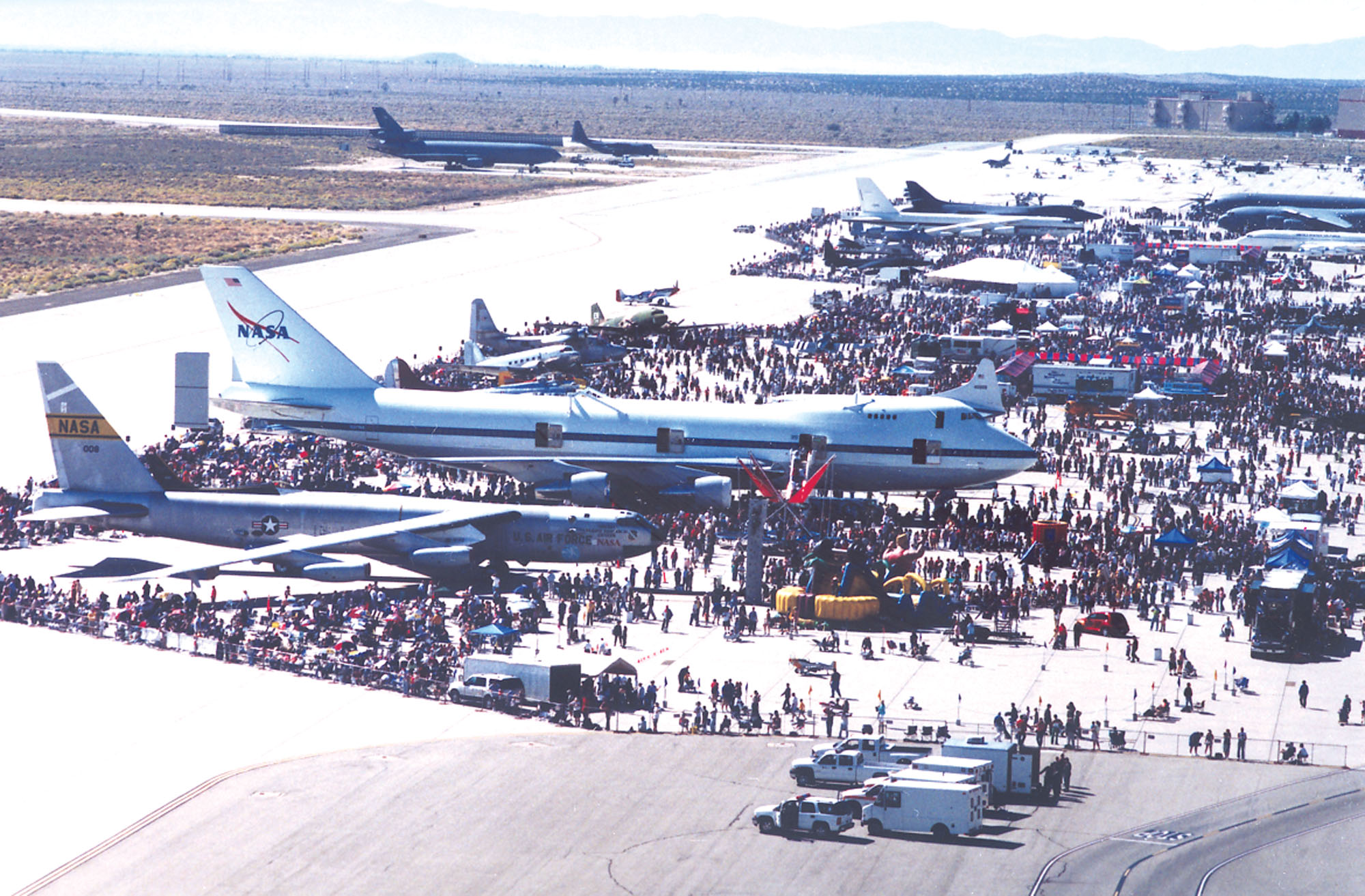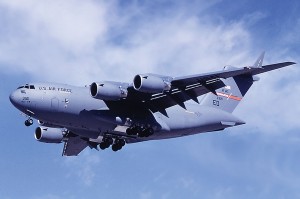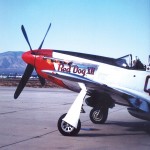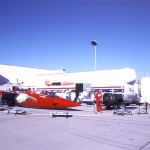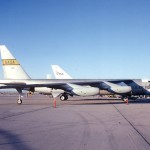By Bob Shane
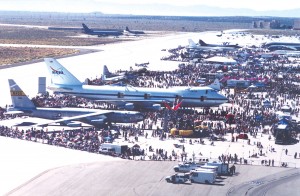
Spectators fill the Edwards AFB flight line, viewing a large array of aircraft and other exhibits on display.
After a two-year hiatus, Edwards Air Force Base hosted a two-day open house October 22-23. Last year, the air show was canceled because of the war effort in Afghanistan and Iraq. This year the event attracted over 120,000 people to California’s Mojave Desert, 100 miles northeast of Los Angeles, to view the nation’s most advanced aircraft.
Edwards Air Force Base is the home of the Air Force Flight Test Center. It was here on Oct. 14, 1947, that Capt. Charles E. “Chuck” Yeager, flying the Bell X-1, became the first man to break the sound barrier. Over the years, it was an Edwards AFB tradition to open the October base air show with a sonic boom made by a jet piloted by Yeager. This year, at precisely 10 a.m., Brig. Gen. Yeager, now retired and a civilian, made a pass in a P-51, while overhead an F-16 made a sonic boom.
The 2005 show was a high-decibel success, with 34 aerial events scheduled and over a mile of static displays. Julie Clark in her T-34 Mentor “Free Spirit” and Greg Medford in his CJ-6 performed civilian aerobatic demonstrations. The U.S. Army parachute team, the Golden Knights, performed their patriotic flag jump. All day long, spectators were treated to the sounds of freedom as an assortment of fighters, bombers and transports demonstrated their capabilities. On display this year were an ever-increasing number of unmanned aerial vehicles, including the Global Hawk and Predator.
Aircraft making demonstrations included the F/A-22 Raptor, which will replace the F-15 as America’s frontline fighter aircraft, as well as the B-52, B-1 and B-2 bombers. The B-2 Spirit stealth bomber closed the show each day and the oldest flying F-117 Nighthawk stealth fighter in the fleet, Ship 782, did a flyby each day. The aircraft was retired following the air show.
Aircraft on static display included the CV-22 Osprey Tiltrotor, the latest in special operations aircraft, as well as a most unusual vehicle, an F-104A (#56-0763) that from 1958 to 1970 had been assigned to the base as a flight-test chase aircraft. Over the years it was flown by a myriad of renowned test pilots such as Yeager, Scott Crossfield, Joe Engle, Pete Knight and Joe Walker, flying chase on milestone test aircraft such as the X-15, XB-70 and SR-71.
Retired from service in 1970, the F-104 ended up in the military boneyard in Tucson, before being surplused out in 1974 to Allied Aircraft, an aircraft salvage dealer. In 1997, Ed Shadle purchased the airframe from its current owner for a special project. The F-104 was resurrected to enter the quest to break the world land speed record of 763 mph (Mach 1.02), set by the British in October 1997.
Shadle and his team have set a goal for themselves of 800 mph (Mach 1.05). Dubbed the “North American Eagle,” the highly modified F-104 (without wings) is a joint venture of Americans and Canadians, all hoping to capture the land speed record.
An invitation to Edwards’ open house included the opportunity to conduct low to medium test runs on Rogers Dry Lake, the landing site for early space shuttle tests and operational flights, during the week following the show. In the following week, the race team was able to get some much needed testing done. The speed brake system was used for the first time and 100 percent power tests were conducted with the F-104 chained to the ground on one of the aircraft test pads. This enabled the team to verify the proper operation of the engine’s afterburner.
According to Shadle, Edwards’ support and interest in the technology gave the project a big push forward. But more help, mainly financial, is still needed. Shadle figures it will take an additional million dollars to finish building what the team hopes will be the world’s fastest supersonic car. The project is in need of a major corporate sponsor; individuals can help by joining the 800 Club (more information can be found at www.landspeed.com). Hopefully, the converted F-104 will be successful in bringing the world land speed record back to North America.
The NASA Dryden Flight Research Center, a civilian tenant organization within the perimeter of Edwards AFB, is a major participant in the open house.
This year, NASA demonstrated its earth science ER-2, a high-flying civil variant of the U-2 reconnaissance aircraft, which performs specialized atmosphere sampling, environmental imaging and sensor validation, satellite calibration and satellite data validation missions around the globe.
On static display was NASA’s B-52B “mothership,” the agency’s oldest aircraft in the fleet, serving almost 50 years, before being retired on Dec. 17, 2004. The tenth B-52 to come off the Boeing assembly line in 1955, it flew 161 captive carry and launch missions in the X-15 program (1959 to 1968). From 1966 to 1975, it carried numerous wingless lifting bodies. This venerable B-52 finished its distinguished career as a launch aircraft for NASA’s Hyper-X program.
Visitors were allowed to tour NASA 911, one of two NASA Boeing 747 shuttle carriers. Acquired from Japan Airlines in 1989, the aircraft was modified to transport space shuttle orbiters from their landing sites back to the launch complex at the Kennedy Space Center.
In the air, NASA demonstrated its highly-modified NF-15B Eagle, outfitted as an intelligent flight control system research aircraft.
To round out the show, the Commemorative Air Force, flying replica Japanese aircraft, put on their “Tora, Tora, Tora” reenactment of the attack on Pearl Harbor.
- Chuck Yeager flew a P-51 during the air show.
- Fire shoots out of the exhaust stacks of the P-51 “Red Dog XII,” as Chuck Yeager attempts to start the engine. Yeager was giving rides to pilots from the Air Force Test Pilot School at Mojave Airport prior to the show.
- Ed Shadle, in the cockpit of the modified F-104, hopes to become the fastest man on the ground.
- The North American Eagle race team sets up their display on the Edwards AFB flight line.
- NASA’s B-52B “mothership” carried the X-15 rocket plane.
- NASA’s B-52B “mothership” carried the X-15 rocket plane.











